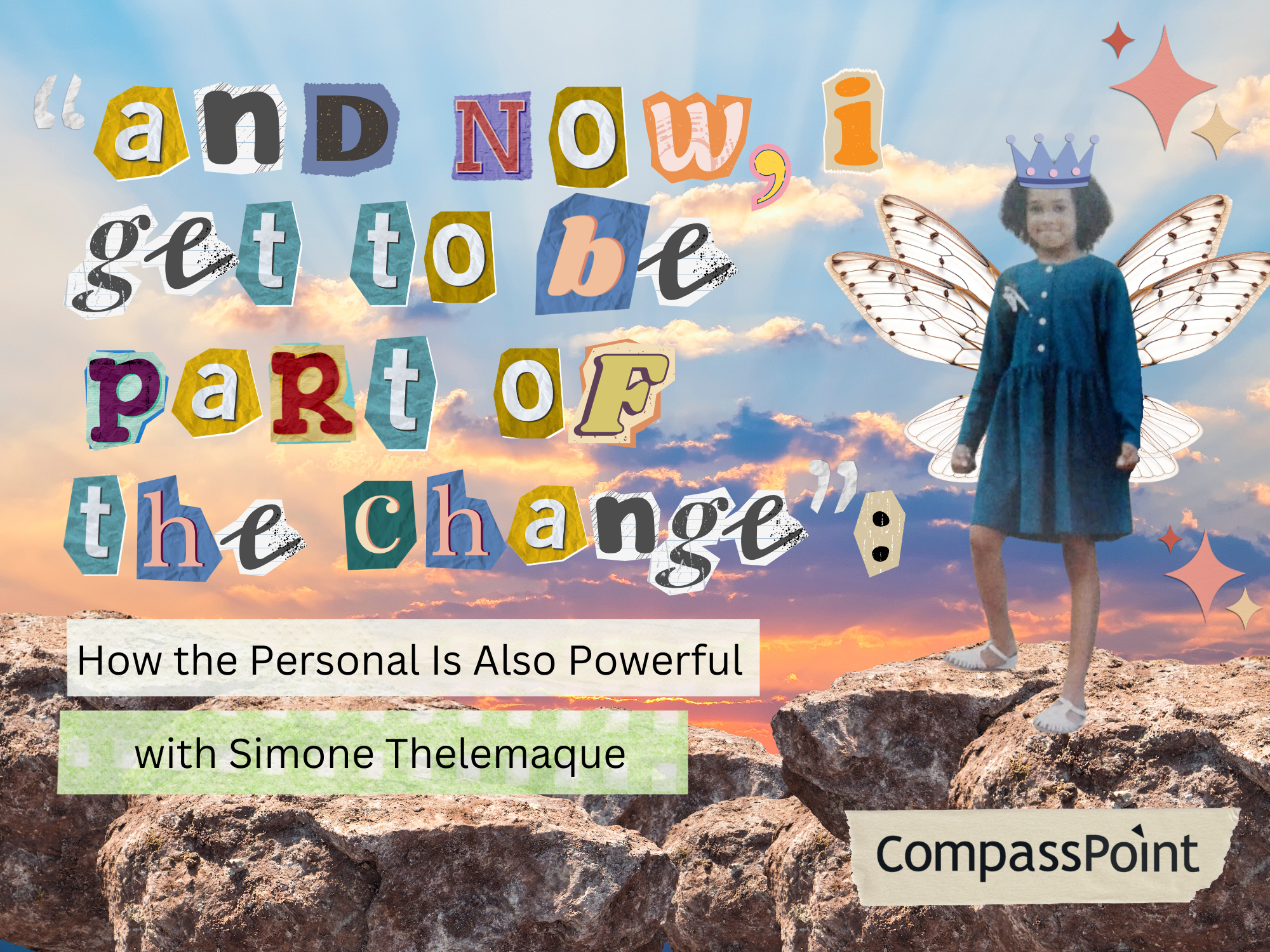In this blog, we share our thinking behind our recent organizational shift to Holacracy, a new organizational operating system that features distributed decision-making and greater role clarity and accountability—and that we feel will help us more fully live out our Theory of Change.
A few months ago, CompassPoint staff gathered as a practice and agreed to head down a transformative path together: implementing a structure called Holacracy as our new management system. What drove us to rethink the way we work will probably resonate with a lot of you:
- Experiencing meetings that leave big issues unresolved and people unsatisfied
- Decision-making bottle-necks that slow down work and overburden managers
- A lack of clarity and transparency around who should or shouldn't perform certain tasks or make certain decisions
- A desire to be more flexible with how we distribute decision making across our organization
- The need to create systems that are responsive so that we can adapt quickly to the rapidly changing world around us
Over the next year, we want to share our learnings about Holacracy with you. In this first blog, we'll go deeper into some of the reasons why we're taking on Holacracy and the way it connects with some of the core values we're trying to live out as an organization.
What Is Holacracy and How Will It Help Us Align to Our Organizational Goals?
Holacracy is a "specific social technology or system of organizational governance…in which authority and decision-making are distributed throughout...self-organizing teams rather than being vested in a management hierarchy" (adapted from https://en.wikipedia.org/wiki/Holacracy). (If you’d like to read more on Holacracy, view the resources we offer at the end of this blog.)
If that sounds a bit heady, we don't blame you. Let's break it down a little. Here are some of the specific features of Holacracy that appealed to us and the way that we seek to work as an organization.
1. Organizing work toward purpose.
Holacratic organizations are powered by purpose. Different "circles," or teams of staff, inside of our system fulfill different purposes. For example, one circle which we've named the "Developing Methods and Content" circle has the purpose to pursue "continuous development of relevant methodology and content." That means that all the roles in that circle will somehow contribute to instigating, challenging, and curating our best thinking on the content that informs our programs and that is most relevant to share with social change leaders looking to make their work more impactful.
By emphasizing purpose, Holacracy encourages us to think how individual, everyday actions contribute to the purpose of our circles, and ultimately, organize around the desired outcomes of our Theory of Change—the real impact we're trying to see realized in the world.
So, instead of asking "Do my team members like this idea?" or "Will this make my supervisor happy?" we're challenging ourselves to organize our work around questions like, "Does this next step I'm taking help social change leaders make a bigger impact in their work and create greater opportunities for social equity?"
2. Thinking about how we distribute power and decision making.
At CompassPoint, we view leadership as a process, and so, Holacracy is a good fit for us in the way it challenges the idea that leadership lives solely in someone's title.
In our first few weeks of taking on Holacracy, we've been encouraged to look beyond our titles to really think about all of the roles we play here, and more importantly, what roles are vital to making CompassPoint's work impactful.
For example, a title like "Communications Director" might be broken down into several roles, including "Annual Report Producer" or "Blog Editor." This allows us to call out every part of our work, including tasks and accountabilities that weren't previously explicit because they didn't fit under the umbrella of a single title.
Distributing decision-making power also means shifting away from a culture based on consensus building. Instead of asking, "Do we all agree on this new proposed idea or action?" Holacracy encourages us to think, "Does this action move us closer to achieving our purpose?" If it does, go for it!
3. Building accountability and transparency.
The goal is to give everyone space to take ownership of their roles and energize them, and move away from a culture of micromanaging. As Brian J. Robertson, the creator of Holacracy puts it, once someone has a role, that person has "the authority to do anything that makes sense […] to get the job done unless there is an explicit rule against it." (The full article where Robertson is quoted can be found here).
The critical step in making that system-wide transparency happen is laying out everyone's work and accountabilities in a way that's always easily accessible to everyone.
We're using a software system called "GlassFrog" to visually represent our dynamic, changing organizational structure. Anyone can log in at any time and see who is accountable for what.
Outlining accountabilities and defining a clear purpose doesn’t just make it clear what kind of work you should say "yes" to, it also helps you see what you can (or should) say "no" to.
Across the organization, there's also a shared responsibility for everyone (not just a traditional executive or managerial team) to be involved in the work of designing the organization. Everyone is tasked with bringing up "tensions." Tensions are simply defined as the difference between a current reality and what's possible. For example, a tension might be "Our donor database is outdated and doesn't let us segment by types of gifts. I'm proposing that we upgrade to this new system that lets us manage those relationships better."
Everyone has the power to enact change that moves us closer to fulfilling our defined purpose, and the person holding the tensions has the responsibility to bring it to the table.
4. Making less room for political maneuvering.
Related to creating more transparency, the rules of Holacracy create a shared understanding around how to make change happen at the organizational level. When people don't know how to make change happen, they use whatever tools are at their disposal, including using their social clout, to broker deals with others and push their agenda through. That's a way of working that privileges some, and leaves others behind. Holacracy makes it very clear how, where, and when to make change happen.
Does that mean politics can't or won't influence the way things get done? That's unlikely. But by being explicit about roles and accountabilities, we're striving to make clear where power lives in the organization, and shining a direct light on it.
5. Creating a constantly evolving organization.
Instead of doing a top-to-bottom organizational overhaul every few years, a Holacratic organization is constantly changing as "tensions" get resolved. A tension might arise around staffing, which could lead to hiring new people, or a tension might arise around what kind of work the organization takes on. Through small, incremental changes, the organization can stay adaptive and responsive to the demands of a quickly changing environment.
People can also move "three-dimensionally" across the organization. What does that mean? Instead of only being able to move up and down the "step-ladder" of an organization's hierarchy, an organization's team members can move in and out of roles fluidly. Someone might hold a role as a "Workshop Facilitator" in one circle, but also be the "Technology Lead" of a different circle—two roles that in a traditional structure might be siloed into different departments but that in a Holacractic system can be fulfilled by the same person. This also allows everyone to lead with their strengths, and energize roles that they’re best suited for, regardless of what department they're a part of or what their title might be.
6. Meetings have a very clear structure and outcomes.
Every meeting has a clear agenda, and every role represented in the room is there to move the purpose of the circle forward. More importantly, instead of focusing on open discussion and building group consensus, Holacracy meetings are highly structured to focus on tracking project updates, and proposing new actions that move our circles (and the whole organization) forward.
If we've learned anything over the last 40 years of working shoulder to shoulder with social change leaders it's that there is no silver bullet when it comes to creating organizational structures that work for everyone, reflect our most closely-held principles around equity and fairness, and help us make the biggest impact.
Still, like many others out there, we sense a deep reckoning across industries and sectors to rethink work in a way that reflects an increasingly connected world—a world that demands more flexibility, creativity, and responsiveness to change.
Holacracy isn’t a quick remedy to anyone’s organizational woes, nor, do we think is it a "one-size-fits-all" solution everyone should take on. Instead, it's a way for us to experiment with new ways of working that challenge us to be more nimble and move past rigid models of organizing that don't feel relevant to the kind of world we live in.
We're looking forward to sharing more first-hand impressions from CompassPoint staff on what it's like to go through such a big change and learn out loud about what's working, what's challenging, and where we think we'll go next. For now, here are just two of the big questions we're keeping live as we go deeper into Holacracy:
- In a system with a strict set of rules determining how we meet, where does empathy and human connection show up and how can we try to prioritize it?
- How do race, power, and privilege show up in our new system, and what checks and balances can we work in to ensure that we distribute roles and decision making in a way that reflects our values of diversity?
Curious about how we're experiencing Holacracy? Leave your questions in the comments section below.
Resources:
- Blog: Read more about Holacracy from Living Orgs, the consultants coaching us through our transition: Living Orgs Blog
- Article: "Holacracy and Self-Organization" (from Zappos)
- Article: "Meet is Murder" (From The New York Times)
- Article: "Making Sense of Zappos and Holacracy" from Forbes





Submit a comment
(4) Comments
Ben Delaney replied on Permalink
Like many nonprofits, it seems that CompassPoint is far more interested in process than accomplishment. I see this as a problem for many in this sector. We spend hours (if not days, weeks, or months) debating HOW to do something, rather than diving in, making mistakes, learning from those mistakes, and moving on.
In my work with nonprofits, I emphasize some of the lessons of Silicon Valley -- experiment, fail early, analyze what when wrong, AND right, and move on. This approach moves us forward toward actually accomplishing our goals and helping our clients.
Rather than writing long reports on our processes and abstract metrics that mask true accomplishments, or lack thereof, we we need to change our focus to meeting our goals, making the world a better place, and helping those who need assistance. It is not obvious that changing your workforce reporting structure will help Compass point do this. I will be watching this experiment with great interest as you move forward.
MarGue replied on Permalink
Thanks for your comment. Part of why we want to share and be transparent about what we're doing is to spark conversation, so thanks for jumping in.
A lot of what you said resonates with us! We agree that focusing on impact and purpose is key. That's one of the reasons we were interested in Holacracy, which insists that every team (or "circle") drive toward measurable goals and metrics. The cycle of iteration you're talking about is really important too, and some other frameworks for thinking about how to do that (like Design Thinking), we think, dovetail nicely with Holacracy, which encourages team members to take bold action to pursue goals. It's a system that has a strong bias toward action, real-time testing, and letting failures and successes play out without excessive meddling from what would typically be a management or supervisory team. Changing the equation of who reports to whom is a significant piece of the puzzle-- but mostly to the degree that it frees up bottlenecks and creates space for everyone to confidently own their roles and focus on next steps to be impactful in their work. The end goal isn't about making managers disappear-- it's about opening up space for everyone to pursue actions, projects, and collaborations without being tightly constrained by a traditional structure, which emphasizes the role of gatekeepers who hold the power to grant "permission."
There are a lot of great critiques of Holacracy out there and the last thing we want to do is present it as a cure-all or quick fix to organizational structures. We're moving forward with optimism and a curious spirit, but also with a healthy dose of skepticism, so thanks again for your comment!
Layli Miller-Muro replied on Permalink
Are there any updates since 2016 on your holacracy journey?
MaroG replied on Permalink
Thanks so much for asking! It's been a loooong time since we shared anything, but we're working on a follow-up blog. The headline was this: it really reset our entire organization in a fundamental way. We'll share more about what worked and what didn't in a longer blog this year.